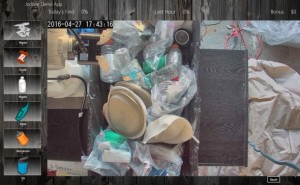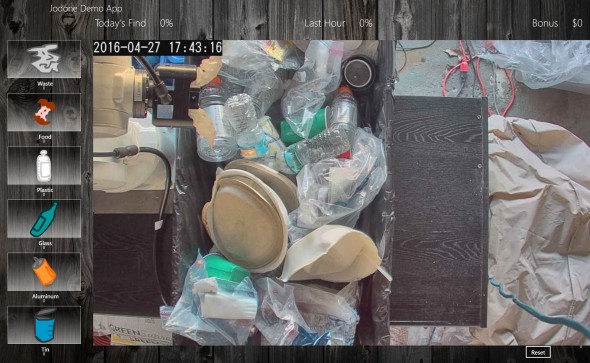
Recycling Workers Vie for Bonuses by Getting Robots to Do the Dirty Work
Recycling Workers Vie for Bonuses by Getting Robots to Do the Dirty Work
A software project has humans collaborating with robots to sort trash.
Sorting waste isn’t fun. Trash can be sticky, stinky, and sharp. The entrepreneurs at Jodone want to turn this mundane task into a human-robot collaborative game to improve efficiency and accuracy.
For Jodone’s new pilot project at the Pope/Douglas waste-to-energy facility in Alexandria, Minnesota, human operators will use Jodone software to monitor waste as it travels along a conveyor belt. Using a touch screen, workers will swipe any recyclables they spot, and then select the appropriate category: paper, plastic, tin, etc. Those instructions will be sent wirelessly to robotic arms that will grab the recyclables and drop them in the correct bin. Workers who salvage above-average amounts of recycling will receive additional income.
“People like solving puzzles, they like being mentally challenged,” says Cole Parker, cofounder and CEO of Jodone. By presenting the job as a puzzle and offering bonuses, Parker believes he can make the job more interesting for workers, which should, in turn, make the operation profitable.
 A software interface allows humans to swipe with a finger on one hand to identify trash and classify it with the other hand.
A software interface allows humans to swipe with a finger on one hand to identify trash and classify it with the other hand.
Jodone estimates that its system—which combines the company’s software with standard industrial robots—will generate $24 million in additional revenue for waste facilities. Under lab conditions, Parker says they have achieved pick rates of 2,500 per hour—eight times higher than a human being alone—with 95 percent accuracy. The pilot project will be the first time the software has been tested outside of the lab.
“We know that robots are great at manual labor—at doing the same thing a million times in a row. But humans are great at problem solving, classification, identification, and dealing with diversity,” explains Parker.
One aspect of the touch-screen software was inspired by the game Fruit Ninja—a user swipes a finger over the recyclable item with the right hand, and then classifies it with the left hand. The developers are also working on a system that will learn from past swipes, so that the software can highlight items it believes should be recycled and wait for human approval.
Michael Rivera, cofounder and chief operating officer at Jodone, estimates the system will cost $150 per ton of recyclables retrieved. The key is reaching a price that’s lower than the cost to landfill the waste, says Harri Holopainen, head of technology at ZenRobotics. The Helsinki, Finland, firm was an early leader in robotic recycling systems, and now sells its systems to waste facilities worldwide. But the ZenRobotics technology is different from Jodone’s in two ways: ZenRobotics relies entirely on software and sensors to identify recyclables, and the company focuses on construction waste. Holopainen says it’s easier to turn a profit in that sector because construction waste tends to be heavier.
Holopainen says he’s a firm believer in gamification, and has worked in that field in the past. But he’s not sure Jodone’s system will be cheap enough for broad adoption if it continues to rely partly on human labor and involves municipal waste.
Moreover, Holopainen says, modern sensors and software can do as good a job as humans. “There’s been a huge investment into techniques that can very rapidly identify contents of images,” he says.
Scott Cassel, CEO and founder of the Product Stewardship Institute, says Jodone’s technology could be helpful but he’s skeptical that it can be cost-effective. Moreover, he’s not sure the public would support such a system for municipal waste. He points to a decision earlier this year that halted construction on a mixed-waste materials recovery facility for municipal waste in Indianapolis. Cassel says the decision was made in part because people thought the money earmarked for the facility should be spent on education programs to encourage people to recycle at home.

Leave a Reply